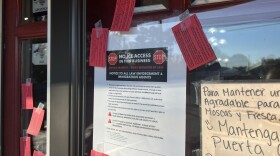In Durham’s Central Park School for Children, classrooms look and feel different than they did just a few years ago. Frankly, the charter school is not as upper-middle class or white as it used to be.
“There’s a greater diversity of viewpoints, there’s a greater diversity of perspectives,” Director John Heffernan explains.
In 2013, the school tried something no other charter school in the state has done before. In collaboration with state education leaders and the financial lender Self-Help, the school began giving students from low-income families a better chance of getting in.
Those who qualify for free and reduced price meals are given priority in the weighted lottery system. Before this rule, only six percent of kids qualified for free and reduced meals. Today, that number is up to 18 percent.

Heffernan says the goal is 40 percent, a number that better reflects the community around them. He explains that the school’s mission is to “take advantage of the differences and diversity, but to also have really great outcomes for kids.”
As the school becomes more economically diverse, the racial demographics are also changing.
Over the last two years, the number of black students has increased by seven percent to 23 percent and the number of white students has decreased from 69 to 61 percent. Meanwhile, the number of Asian and Latino students is rising.
Outside of Central Park, it’s different story.
Disproportionately White, Disproportionately Minority
“We’ve got disproportionately white charter schools and disproportionately minority charter schools,” says Helen Ladd, a professor at Duke University’s Sanford School of Public Policy.
Ladd explains that the state’s charter schools have always been racially imbalanced and that it’s only gotten worse. According to a report she co-authored, more than two-thirds of charter school students attend schools that are either predominantly minority or predominantly white.
“It’s [increased racial segregation] is what we’ve worked hard to avoid or get rid of,” Ladd says. “To be sure, it’s a relatively small percentage of students in charter schools, so this phenomenon matters more in some of the school districts in the state than others, but, nonetheless, it’s a pattern worth worrying about.”
Initially, black students were over-represented in charter schools. Today, that’s true for white students. The percentage of charter school kids in mainly white schools has almost doubled since the late 1990s.
To answer why that’s happening, Ladd thinks like an economist. On the demand side, you’ve got parents. Research shows that in addition to examining educational resources, families also consider the racial mix of a school when deciding where to send their kid.
Providing Transportation and Meals
“The other side is what the charter school operators are trying to do, that’s the supply side,” Ladd says.
Some advocates see charter schools as an equalizer, as a way of providing options to low-income families who are struggling in low-performing schools. Many schools offer unique and specialized programs.
However, unlike traditional public schools, they do not have to offer free and reduced meals or bus transportation. Ladd thinks they should.
“Because if they don’t then they’re not really open to all students who need those services,” Ladd explains.
“Yeah, I’m going to disagree with that philosophy,” says Joe Maimone, a member of the state’s charter school advisory board and headmaster of Thomas Jefferson Classical Academy in Cleveland County.
Maimone says parents want the best schooling option for their kid “even if that means they have to sacrifice a little bit more in terms of not having the free lunch or not having transportation door-to-door.”
He also points out that charter schools do not get the same amount of funding as traditional public schools. Still, many charter schools coordinate carpools and run a few buses that meet in central locations.
“Charter schools have done, and will continue to do everything they can to make sure transportation is not a barrier,” he explains.
‘Charter Schools Can’t Pick and Choose Students’
In terms of the makeup of the student population, advocates argue that the state’s 158 charter schools can’t pick and choose who will apply.
“There’s no mechanism by which charter schools can ensure racial and ethnic balance,” says Lee Teague, director of Public Relations & Grassroots Development of the N.C. Public Charter Schools Association.
A controversial state report recently revealed more than 57 percent of charter school students are white, compared to 49.5 percent at traditional public schools. The percentage of black students is nearly the same across both types of schools, while the proportion of Hispanic students at traditional public schools is about twice the percentage at charter schools.
Teague argues it’s not fair to compare the state’s 158 charter schools to all of the state’s traditional schools, which are well distributed geographically.
He adds that many charters have strong missions that focus solely on minority and economically disadvantaged students.
Many charter school critics support high-performing schools geared toward minorities, but say they worry about the other side: families opting out of a racially diverse school system in favor of disproportionately white charter school.

At Central Park School for Children, parent Zoila Salazar says she appreciates her school’s efforts to diversify.
Salazar and her kindergarten son had a higher chance of getting into this school last year because of their socioeconomic status. She also says it was important that the charter school was able to help out with transportation and meals.
“He wouldn’t be here right now if they didn’t provide transportation or free meals because it would’ve been so hard for me to bring him,” she says.
Central Park is the only school in the state that holds a weighted lottery, but education leaders are considering giving other schools that option.
Some see it as a way of helping to fulfill one of the big goals of charter schools: to serve disadvantaged students.










